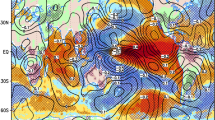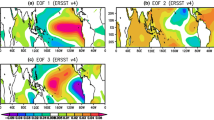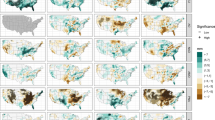Abstract
The El Niño Southern Oscillation (ENSO) is the Earth’s strongest climate fluctuation on inter-annual time scales and has global impacts although originating in the tropical Pacific. Many point indices have been developed to describe ENSO but the Multivariate ENSO Index (MEI) is considered as the most representative since it links six different meteorological parameters measured over the tropical Pacific. Extreme values of MEI are correlated to the extreme values of atmospheric CO2 concentration rate variations and negatively correlated to equivalent scale extreme values of the length of day rate variation. We evaluate a first-order conversion function between MEI and the other two indexes using their annual rate of variation. The quantification of the strength of the coupling herein evaluated provides a quantitative measure to test the accuracy of theoretical model predictions. Our results further confirm the idea that the major local and global Earth–atmosphere system mechanisms are significantly coupled and synchronized to each other at multiple scales.




Similar content being viewed by others
References
Bacastow RB (1976) Modulation of atmospheric carbon dioxide by the Southern Oscillation. Nature 261:116–118
Curry JA, Webster PJ (2011) Climate science and the uncertainty monster. Bull Am Meteorol Soc. doi:10.1175/2011BAMS3139.1
Deser C, Wallace JM (1990) Large-scale atmospheric circulation features of warm and cold episodes in the tropical Pacific. J Climate 3:1254–1281
Douglass DH, Christy JR, Pearson BD, Singer SF (2007) A comparison of tropical temperature trends with model predictions. Int J Climatol. doi:10.1002/joc.1651
Graf H-F, Zanchettin D (2012) Central Pacific El Niño, the “subtropical bridge”, and Eurasian climate. J Geophys Res 117:D01102
Lambeck K (1980) The Earth’s variable rotation. Cambridge University Press, Cambridge, p 449
Mazzarella A (2008) Solar forcing of changes in atmospheric circulation, Earth’s rotation and climate. Open Atmos Sci J 2:181–184
Mazzarella A (2009) Sun–climate linkage now confirmed. Energy Environ 20:123–130
Mazzarella A, Giuliacci A (2009) The El Niño events: their classification and scale-invariance laws. Ann Geophys 52:517–522
Mazzarella A, Scafetta N (2012) Evidences for a quasi 60-year North Atlantic Oscillation since 1700 and its meaning for global climate change. Theor Appl Climatol 107:599–609
McLean JD, de Freitas CR, Carter RM (2009) Influence of the Southern Oscillation on tropospheric temperature. J Geophys Res 114:D14104. doi:10.1029/2008JD011637
Meehl G, Arblaster J, Fasullo J, Hu A, Trenberth K (2011) Model-based evidence of deep-ocean heat uptake during surface-temperature hiatus periods. Nat Clim Chang. doi:10.1038/nclimate1229
Patra PK, Maksyutov S, Nacazawa T (2005) Analysis of atmospheric CO2 growth rates at Mauna Loa using CO2 fluxes derived from an inverse model. Tellus 57B:357–365
Philander SG, Fedorov A (2003) Is El Niño sporadic or cyclic? Annu Rev Earth Planet Sci 31:579–594
Rosen RD, Salstein DA (1985) Contribution of stratospheric winds to annual and semiannual fluctuations in atmospheric angular momentum and the length of day. J Geophys Res 90(D5):8033–8041
Scafetta N (2010) Empirical evidence for a celestial origin of the climate oscillations and its implications. J Atmos Solar-Terr Phys 72:951–970
Scafetta N (2012a) A shared frequency set between the historical mid-latitude aurora records and the global surface temperature. J Atmos Solar-Terr Phys 74:145–163
Scafetta N (2012b) Testing an astronomically based decadal-scale empirical harmonic climate model versus the IPCC (2007) general circulation climate models. J Atmos Solar-Terr Phys 80:124–137
Scafetta N (2012c) Multi-scale harmonic model for solar and climate cyclical variation throughout the Holocene based on Jupiter–Saturn tidal frequencies plus the 11-year solar dynamo cycle. J Atmos Solar-Terr Phys 80:296–311
Spencer RW, Braswell WD (2011) On the misdiagnosis of surface temperature feedbacks from variations in Earth's radiant energy balance. Remote Sens 3:1603–1613
Stephenson FR, Morrison LV (1995) Long-term fluctuations in Earth's rotation: 700 BC to AD 1990. Phil Trans R Soc A 35:165–202
Tsonis AA, Swanson KL, Wang G (2008) On the role of atmospheric teleconnections in climate. J Climate 21:2990–3001
Wallace JM (1998) On the structure and evolution of ENSO-related climate variability in the tropical Pacific: lessons from TOGA. J Geoph Res 103:14,241–14,259
Wang C, Fiedler PC (2006) ENSO variability and the eastern tropical Pacific: a review. Prog Oceanogr 69:239–266
Wang Z, Wu D, Song X, Chen X, Nicholls S (2012) Sun–moon gravitation-induced wave characteristics and climate variation. J Geophys Res 117:D07102
Wolter K, Timlin MS (1993) Monitoring ENSO in COADS with a seasonally adjusted principal component index. Proceedings of the 17th Climate Diagnostics Workshop, Norman, OK, NOAA/N MC/CAC, NSSL, Oklahoma Climate Survey, CIMMS and the School of Meteorology, University of Oklahoma, pp 52-57
Wolter K, Timlin MS (1998) Measuring the strength of ENSO events—how does 1997/98 rank? Weather 53:315–324
Wolter K, Timlin MS (2011) El Niño/Southern Oscillation behaviour since 1871 as diagnosed in an extended multivariate ENSO index (MEI.ext). Intl J Climatol 31:1074–1087
Wyatt MG, Kravtsov S, Tsonis AA (2011) Atlantic Multidecadal Oscillation and Northern Hemisphere’s climate variability. Clim Dyn. doi:10.1007/s00382-011-1071-8
Zheng DW, Ding X, Zhou Y, Chen Y (2003) Earth rotation and ENSO events: combined excitation of interannual LOD variations by multiscale atmospheric oscillations. Glob Planet Chang 36:89–97
Author information
Authors and Affiliations
Corresponding author
Rights and permissions
About this article
Cite this article
Mazzarella, A., Giuliacci, A. & Scafetta, N. Quantifying the Multivariate ENSO Index (MEI) coupling to CO2 concentration and to the length of day variations. Theor Appl Climatol 111, 601–607 (2013). https://doi.org/10.1007/s00704-012-0696-9
Received:
Accepted:
Published:
Issue Date:
DOI: https://doi.org/10.1007/s00704-012-0696-9




